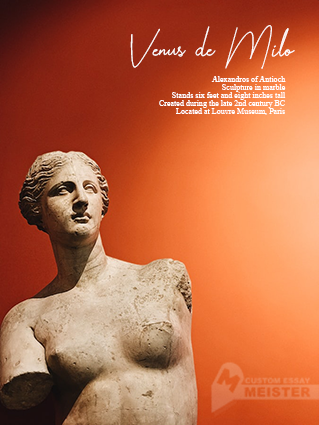How to Write a Visual Analysis
If there is one thing that you really need to meet in writing a visual analysis, that is, it has to be compelling. While there is no standard process in writing a visual analysis, there is still a need to ensure that your readers can vividly imagine the image, whatever it is, that you are trying to analyze. You may think that it is a visual analysis, so the analysis part is what is most important – true, but it is not the only thing that matters. You saw the visual and you can understand it - that is just half the task. The key is to allow your readers to understand the visual as well as your perception of the artwork simultaneously, following at least the basic structure of an essay. Without further ado, this is the only guide you need on how to write a visual analysis.
How do I start my visual analysis?
The visual is any piece of artwork, be it a painting, a photograph, a sketch, or a sculpture, among others. Note that a visual analysis essay is a form of descriptive essay – this basically means that your visual analysis must offer vivid descriptions. Begin with offering your readers the facts of your visual:
1. What type of art is it?
2. What is the title of the visual, if any?
3. Who is/are the artist/s?
4. When and where was it made?
5. What is it made of (e.g. oil on canvass, etc.)?
6. What are the dimensions of the visual?
These details should be included added in as you write your introduction. You can either begin with these details followed by your thesis or vice versa, but however you decide, do not forget to use a hook for your essay . For instance, you can inform your readers why the artwork was made by interpreting the intention of the artist. If possible, always include a photograph of your visual, unless otherwise instructed. This allows your readers to instantly connect with your thoughts by either agreeing with you or not. Then again, it just justifies the need for you to give vivid details for your reader should you not be allowed to include the visual in your paper.
Can an outline help me?
Yes, and by all means, please draft your outline if you feel the need to do so, especially if your thoughts are on a roll. Outlines are meant to guide your essay to the direction you want it to go as well as keep your essay intact. Learning how to make an effective outline allows you to wrap up your ideas in unison, preventing your visual analysis, or any other essay, from going haywire. Before you start pondering about the body of your paper, ensure that you have developed a clear thesis statement. The body of your paper can have at least three main points to support your thesis statement. For a visual analysis:
- You can emphasize the historical background of the artwork. Is it of significant value to its era? Is it of great importance to any past or contemporary social issue?
- You can emphasize the thoughts of the artist. What is the artist’s intention? What are your thoughts in relation to that intention? Can you identify subtle symbolism?
- You can emphasize the techniques utilized by the artist. Ensure that every main point supports your thesis statement.
- You can add a counterargument if you think it is of value to your visual analysis, but do not forget to refute the counterargument to return to your thesis statement.
-
Conclude with a striking remark which can allow your readers to further think about the visual. You can compare and contrast that one visual among the other works of the same artist or to another artists’ works, other than briefly summarizing your paper. It is better to offer an intriguing thought at the end of a visual analysis because its very nature is subjective.
Paint a picture in your reader’s mind.
The goal in writing a visual analysis is to offer vivid descriptions along with the scholarly interpretation of the visual - it is like writing a descriptive essay . You let your readers see what you see to understand your essay. You cannot just say that the visual is a painting of a woman by John Smith. Understand that it has to be detailed, hence, you need to take your time in studying the visual as well. After all, you cannot write about anything you do not know, hence, know your visual. Once you are confident that you have enough knowledge about your visual, that is the only time when you can see all possible thesis statements you can discuss. Be as descriptive as you can – discuss the colors, the dimensions, the texture, the style and technique – allow your words to form the image, again, so that your readers can understand you better.
Compare.
This is an obvious rain check practice - compare your description with your visual. Do they match? Understand that not all visual analyses allow you to include an image of your visual. One more important thing, cross-check the artworks, some colors or hues vary when seen in person and in photograph especially those that are made available online. It will not hurt to check some museum or exhibit web pages to see legitimate photos of an artwork.
Cite the artist and your reading materials.
Art, although subjective, still has innate objectivity. For instance, the color red can represent a person or an entire country in a certain time frame, so, read your history books as art and history are closely related, and like any other academic essay, cite your sources. You do not want to end up justifying that you did not plagiarize your work.
Revise.
Take a quick rest, enjoy your favorite drink or walk around. Just stay away from your paper for at least an hour so you can forget everything about it, then come back later with a fresh eyes and mind to see your errors. Proofread your work. Treat your visual analysis like it is an artwork too, and like any other artist, you would want your work to be perfect. Pro tip: look for other tips for editing your paper, too.
Visual analyses are highly subjective and is very good way to appreciate the arts all while acing your class.
Visual analysis writing service for students
Is your visual analysis assignment still proving to be tricky? Fret not, we know just how to help you! As one of the leading writing services on the market, CustomEssayMeister can take on your visual analysis essay for you. Our professional writers are experts from various respective fields, one of them being art and art analysis. If you wish to seek our services, contact our Support Team now!

